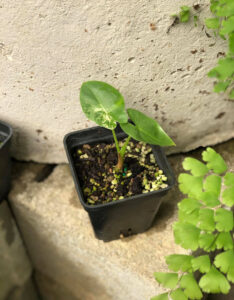Basic Information
Explore the captivating world of Alocasia Macrorrhiza, a stunning plant with lush foliage and tropical allure. Our guide provides you with essential care instructions, including its preference for bright, indirect light and warm, humid environments. Whether you’re a beginner or an experienced plant lover, you’ll learn how to balance watering, soil composition, and temperature management to ensure your Alocasia thrives in your care.



Light
Alocasia Macrorrhiza thrives in bright, indirect light, mimicking its natural rainforest habitat under tree canopies. Direct sunlight is tolerable but should be limited to two hours daily, with the morning sun being the least harsh. An ideal indoor spot is near east, south, or north-facing windows. Insufficient light leads to poor growth, while too much direct sun can scorch the leaves.
Water
To keep this plant healthy, it’s important to water it once the top inch of soil has dried out. While it can tolerate occasional standing water, be careful not to overwater it as this can cause root rot. During the warmer months, increase the frequency of watering, but be sure to reduce it during the colder season when the plant is dormant. Consistent watering, adjusted for seasonal changes, is crucial for maintaining the health of the plant.
Soil
To grow Alocasia Macrorrhiza successfully, a well-draining soil mixture consisting of regular potting soil, peat moss, and perlite is required. This combination helps to retain the right amount of moisture and allows for proper drainage, which is critical in preventing waterlogging and root diseases. It is recommended to maintain the pH levels between 5.7 to 6.3, which is slightly acidic to neutral, to aid in nutrient absorption and promote healthy growth of the plant.
Temperature
Alocasia Macrorrhiza is a tropical plant that requires a warm environment to thrive. It grows best in temperatures between 55 to 85°F (13 to 29°C) and cannot withstand cold weather. Therefore, it is essential to protect it from temperatures below 50°F (10°C). The ideal growing conditions for this plant are in USDA hardiness zones 9b to 12. To maintain stable temperatures, it is necessary to keep the plant away from drafty windows and air conditioning.
Humidity
High humidity levels of 50 to 60% mimic the Alocasia’s native tropical environment. In drier conditions, use a humidifier or mist the leaves to increase humidity. Grouping it with other tropical plants can also help create a more humid microclimate. Be cautious of overly dry air, which can cause leaf tip browning.
Fertilizer
As a heavy feeder, Alocasia Macrorrhiza benefits from regular fertilization during its growth months. Apply a diluted all-purpose houseplant fertilizer every two weeks in spring and summer. Be careful not to overfertilize, as this can lead to root burn and yellowing leaves. During dormancy in winter, reduce or pause fertilization.
Growth Rate
Known for its rapid growth, Alocasia Macrorrhiza can reach impressive sizes, necessitating ample space for its development. It can grow several feet in both height and width, making it a dominant feature in any indoor or outdoor setting. Its growth rate is influenced by proper care, including adequate light, water, and nutrients.
Pet Safety
This plant contains calcium oxalates, making it toxic to both humans and pets. Consumption can cause irritation and health complications, so it’s essential to keep the plant out of reach, especially from curious pets and children. Handling the plant should be done with care to avoid skin irritation.
Grow in Semi-Hydro
- Alocasia plants excel in Semi-hydroponics (LECA/Pon) due to their natural inclination for root growth and humidity.
- Successfully transitioning Alocasia to Semi-hydroponics is enhanced with a Nutrient Stagnant Wicking (NSW) setup.
- Alocasia roots adapt seamlessly to the water in LECA/Pon, with quick resolution of any root hair issues in NSW setups.
- Fertilizer includes a nutrient mix concentration of approximately 800-1000ppm.
- These plants are versatile in different temperature and humidity settings, thriving in controlled environments.
- Long-term care involves maintaining a constant water reservoir and performing occasional system flushes for sustained growth.
Tips
- Water with lukewarm water to avoid shocking the plant’s sensitive root system.
- Ensure the pot has adequate drainage to prevent root rot.
- Increase humidity around the plant using misting techniques or a pebble tray.
- Clean the large leaves regularly to improve photosynthesis and prevent dust buildup.
- Avoid chemical leaf shiners; use a damp cloth to clean leaves.
Transform your Alocasia Macrorrhiza into a stunning indoor garden centerpiece with these guidelines.
Happy planting! 🌱


